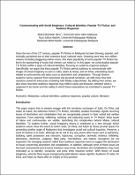Options
Communicating with Social Imaginary: Cultural Identities, Popular TV Fiction, and Audience Responses
Date Issued
2016
Author(s)
Mohd Muzhafar Idrus
Ruzy Suliza Hashim
Raihanah Mohd Mydin
Abstract
Since the turn of the 21st century, popular TV fiction in Malaysia has been thriving, popular, and
critically-acclaimed due to their extensive local, national reach. Drawing more than one million
viewers including staggering online reruns, this sheer popularity of some popular TV fiction has
led to the questioning of issues that viewers can relate to. In this paper, we contextualize popular
TV fiction within a space of cultural identities, focusing on audience-response analysis.
Specifically, we argue that these popular TV fiction permit audience to communicate with
images of social imaginary as seen in Julia, Adam & Hawa, and On Dhia, articulating issues
related to controversies and taboo such as alcoholism and cohabitation. Through diverse
audience voices captured from interviews and personal narratives, we will show how their
reactions reveal the intricacies of dealing with Malay subjectivities. By telling their stories, we
also show how these audience responses may reflect cracks and fractures, between what is
supposed to be shown and the reality in which these expectations are translated in popular TV
fiction.
critically-acclaimed due to their extensive local, national reach. Drawing more than one million
viewers including staggering online reruns, this sheer popularity of some popular TV fiction has
led to the questioning of issues that viewers can relate to. In this paper, we contextualize popular
TV fiction within a space of cultural identities, focusing on audience-response analysis.
Specifically, we argue that these popular TV fiction permit audience to communicate with
images of social imaginary as seen in Julia, Adam & Hawa, and On Dhia, articulating issues
related to controversies and taboo such as alcoholism and cohabitation. Through diverse
audience voices captured from interviews and personal narratives, we will show how their
reactions reveal the intricacies of dealing with Malay subjectivities. By telling their stories, we
also show how these audience responses may reflect cracks and fractures, between what is
supposed to be shown and the reality in which these expectations are translated in popular TV
fiction.
Subjects
File(s)
Loading...
Name
Communicating with Social Imaginary.pdf
Size
17.49 KB
Format
Adobe PDF
Checksum
(MD5):5d5a038d30d0036bde8e706885923ba9